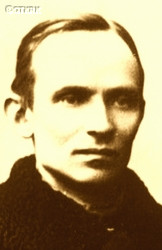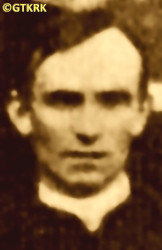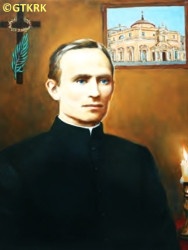Roman Catholic
St Sigismund parish
05-507 Słomczyn
85 Wiślana Str.
Konstancin deanery
Warsaw archdiocese, Poland
full list:
displayClick to display full list

searchClick to search full list by categories
wyświetlKliknij by wyświetlić pełną listę po polsku

szukajKliknij by przeszukać listę wg kategorii po polsku

Martyrology of the clergy — Poland
XX century (1914 – 1989)
personal data
religious status
Servant of God
surname
TROJGO
forename(s)
John (pl. Jan)
function
diocesan priest
creed
Latin (Roman Catholic) Church RCmore on
en.wikipedia.org
[access: 2014.09.21]
diocese / province
Mogilev archdiocesemore on
en.wikipedia.org
[access: 2013.06.23]
academic distinctions
Sacred Theology MA
date and place
of death
11.08.1932

Sankt Petersburgtoday: Saint Petersburg city, Russia
more on
en.wikipedia.org
[access: 2020.07.31]
details of death
Arrested by the Russians on 10.03.1923.
In a show trial of Abp Cieplak and 13 Catholic priests on 21‐25.03.1923 sentenced to 3 years in prison.
Held in Sokolnicheskyi prison in Moscow.
Released in 01.1935.
Returned to Sankt Petersburg.
Arrested again on 14/15.01.1927 together with Fr Paul Chomicz and Fr Anthony Wasilewski, and 6 students of clandestine theological seminary run in Fr Wasilewski's apartment among others.
Accused of „maintaining a criminal relationship with priests and representatives of Polish authorities and teaching children in a religious spirit”.
On 18.07.1927 sentenced by a criminal Russian OGPU Council kangaroo court to 5 years of slave labour.
On 30.07.1927 transported to ITL SLON slave labour camp on Solovetsky Islands.
In 06.1929 transferred to Anzer Island concentration camp.
On 05.07.1932 arrested again and tried in a process of Catholic priests held in Anzer and Solovetsky Islands concentration camps accused of „founding a society conducting anti–Russian agitation and illegal rites and maintaining illegal contacts aimed at passing abroad information about fate of the Catholics in Russia”.
Repeatedly interrogated and urged to give up priesthood and faith.
Refused.
During interrogations fell ill.
On 22.07.1932 sent to Sankt Petersburg where perished in genocidal NKVD organisation's prison hospital.
cause of death
extermination: exhaustion and disease
perpetrators
Russians
sites and events
Sankt Petersburg (Kresty)Click to display the description, Trial of 05.07.1932Click to display the description, OLP AnzerLagClick to display the description, ITL SLONClick to display the description, GulagClick to display the description, Moscow (Matrosskaya Tishina)Click to display the description, Trial of 21‐25.03.1923Click to display the description
date and place
of birth
30.12.1880

Progalinawilderness n. Romanówka
today: non‐existent, Sidra gm., Sokółka pov., Podlaskie voiv., Poland
more on
en.wikipedia.org
[access: 2022.01.28]
alt. dates and places
of birth
12.12.1880, 29.12.1881
presbyter (holy orders)
ordination
10.08.1906

Vilniustoday: Vilnius city dist., Vilnius Cou., Lithuania
more on
en.wikipedia.org
[access: 2022.01.06]
positions held
1925 – 1927
parish priest — Sankt Petersburgtoday: Saint Petersburg city, Russia
more on
en.wikipedia.org
[access: 2020.07.31] ⋄ St Stanislav the Bishop and Martyr RC parish ⋄ Sankt Petersburgtoday: Saint Petersburg city, Russia
more on
en.wikipedia.org
[access: 2020.07.31] RC deanery
editor — Sankt Petersburgtoday: Saint Petersburg city, Russia
more on
en.wikipedia.org
[access: 2020.07.31] ⋄ Catholic magazines — also: publisher
from 1917
chaplain — Sankt Petersburgtoday: Saint Petersburg city, Russia
more on
en.wikipedia.org
[access: 2020.07.31] ⋄ shelter for wounded soldiers
1916 – 1918
prefect — Sankt Petersburgtoday: Saint Petersburg city, Russia
more on
en.wikipedia.org
[access: 2020.07.31] ⋄ gymnasiums for women
from 1914
employee — office, to Metropolitan ⋄ Mogilev RC archdiocese — secretary, member of the Administrative Council of the Curia, the Episcopal Court and chairman of the Economic Council of the Roman Catholic Clerical College
1910 – 1914
professor — Sankt Petersburgtoday: Saint Petersburg city, Russia
more on
en.wikipedia.org
[access: 2020.07.31] ⋄ liturgy, Metropolitan Theological Seminary — also: librarian
1908 – 1910
prefect — Mohyliv‐Podilskyitoday: Mohyliv‐Podilskyi urban hrom., Mohyliv‐Podilskyi rai., Vinnytsia obl., Ukraine
more on
en.wikipedia.org
[access: 2021.09.17] ⋄ secondary schools
1904 – 1908
student — Sankt Petersburgtoday: Saint Petersburg city, Russia
more on
en.wikipedia.org
[access: 2020.07.31] ⋄ philosophy and theology, Imperial Roman Catholic Spiritual Academy (1842‐1918) — postgraduate specialised studies, crowned on 28.05.1908 with the title of Master of Sacred Theology, based on the diploma theses: Lat.: „Metropolita Kiioviensis et eius merita in unione Ecclesiarum” (Eng. „The Metropolitan of Kiev and His Merits for the Unity of the Church”) and Rus. „О романе Ф. М. Достоевского 'Преступление и наказание'” (Eng. „On the Novel by Fyodor M. Dostoyevsky, 'Crime and Punishment'”)
1900 – 1904
student — Sankt Petersburgtoday: Saint Petersburg city, Russia
more on
en.wikipedia.org
[access: 2020.07.31] ⋄ philosophy and theology, Metropolitan Theological Seminary
others related
in death
BUDKIEWICZClick to display biography Constantine Romualdo, CHODNIEWICZClick to display biography Paul, CHWIEĆKOClick to display biography Lucian, EJSMONTClick to display biography Stanislav, JANUKOWICZClick to display biography Peter, RUTKOWSKIClick to display biography Francis, TURŁOClick to display biography Joseph, TYSSOWSKIClick to display biography Casimir, WASILEWSKIClick to display biography Anthony Raymond, WORONKOClick to display biography Casimir
sites and events
descriptions
Sankt Petersburg (Kresty): Russian prison in Sankt Petersburg where many Polish priests were kept captive. Many of them were also murdered there. (more on: en.wikipedia.orgClick to attempt to display webpage
[access: 2014.12.20])
Trial of 05.07.1932: Russian trial of Catholic priests held in Solovetsky Islands and Anzer Island, accused of „creation of an anti‐Russian group that conducted anti‐Russian agitation, clandestinely celebrated Mass and religious rites and maintained an illegal contact with a free worker for purposes of transmitting abroad information of an espionage character about the situation of Catholics in the Russia”. The prisoners were given prolonged sentences in concentration camp and spread them among the various Gułag camps.
OLP AnzerLag: Russian Rus. Отдельный лагерный пункт (Eng. Separate Camp Unit) OLP on the Anzer Island on White Sea. On the Island, 47 km2, belonging to Solovetsky Islands archipelago, Russians organised one of the first concentration camps in Russia (part of ITL SLON Solovetsky Islands concentratoin camp). In 1930s c. 32 Catholic priests were held there most of who perished. (more on: en.wikipedia.orgClick to attempt to display webpage
[access: 2014.12.20])
ITL SLON: Russian Rus. Исправи́тельно‐Трудово́й Ла́герь (Eng. Corrective Labor Camp) ITL Rus. Солове́цкий ла́герь осо́бого назначе́ния Ла́герь (Eng. Solovetsky Special Purpose Camp) SLON — concentration and slave forced labor camp (within what was to become Gulag complex) — headquartered in Solovetsky Islands in Arkhangelsk Oblast. Founded on 13.10.1923 in a famous Orthodox monastery. In the 1920s, one of the first and largest concentration camps in Russia. The place of slave labor of prisoners — at forest felling, sawmills, peat extraction, fishing, loading work on the Murmansk Railway Main Line, in road construction, production of food and consumer goods, at the beginning of the construction of the White Sea ‐ Baltic canal, etc. The concept of the later system of Russian Gulag concentration camps prob. had its origins in the Solovetsky Islands camp — from there the idea spread to the camps in the area covered by the construction of the White Sea ‐ Baltic canal, i.e. ITL BelBaltLag, and from there further, to the entire territory of the Russian state. From the network of camps on the Solovetsky Islands — also called the Solovetsky Islands archipelago — prob. also comes the concept of the „Gulag Archipelago” created by Alexander Solzhenitsyn. It is estimated that tens to hundreds of thousands of prisoners passed through the Solovetsky Islands concentration camps. At its peak, c. 72,000 prisoners were held there: e.g. 14,810 (12.1927); 12,909 (03.1928); 65,000 (1929); 53,123 (01.01.1930); 63,000 (01.06.1930); 71,800 (01.01.1931); 15,130 (1932); 19,287 (1933) — c. 43,000 of whom were murdered, including the years 1937‐1938 when c. 9,500 prisoners were transported from the camp and murdered in several places of mass executions, including Sandarmokh, Krasny Bor and Lodeynoye Polye. Among them were many Catholic and Orthodox priests. After the National Socialist Party came to power in Germany in 1933, a German delegation visited the ITL SLON camp, to „inspect” Russian solutions and adopt them later in German concentration camps. It operated until 04.12.1933, with a break from 16.11.1931 to 01.01.1932, when it was part of and later became a subcamp of the ITL BelBaltLag camp. It operated as such until 1939 (from 1936 as a prison). (more on: old.memo.ruClick to attempt to display webpage
[access: 2024.04.08])
Gulag: The acronym Gulag comes from the Rus. Главное управление исправительно‐трудовых лагерей и колоний (Eng. Main Board of Correctional Labor Camps). The network of Russian concentration camps for slave labor was formally established by the decision of the highest Russian authorities on 27.06.1929. Control was taken over by the OGPU, the predecessor of the genocidal NKVD (from 1934) and the MGB (from 1946). Individual gulags (camps) were often established in remote, sparsely populated areas, where industrial or transport facilities important for the Russian state were built. They were modeled on the first „great construction of communism”, the White Sea‐Baltic Canal (1931‐1932), and Naftali Frenkel, of Jewish origin, is considered the creator of the system of using forced slave labor within the Gulag. He went down in history as the author of the principle „We have to squeeze everything out of the prisoner in the first three months — then nothing is there for us”. He was to be the creator, according to Alexander Solzhenitsyn, of the so‐called „Boiler system”, i.e. the dependence of food rations on working out a certain percentage of the norm. The term ZEK — prisoner — i.e. Rus. заключенный‐каналоармец (Eng. canal soldier) — was coined in the ITL BelBaltLag managed by him, and was adopted to mean a prisoner in Russian slave labor camps. Up to 12 mln prisoners were held in Gulag camps at one time, i.e. c. 5% of Russia's population. In his book „The Gulag Archipelago”, Solzhenitsyn estimated that c. 60 mln people were killed in the Gulag until 1956. Formally dissolved on 20.01.1960. (more on: en.wikipedia.orgClick to attempt to display webpage
[access: 2024.04.08])
Moscow (Matrosskaya Tishina): One of Moscow prisons, set up in 1775 in Sokolniki district, thus at times known as Sokolnicheskyi prison. (more on: en.wikipedia.orgClick to attempt to display webpage
[access: 2019.10.13])
Trial of 21‐25.03.1923: Show trial against abp John Cieplakow, 14 Catholic priest and one lay Catholic held on 21‐25.03.1923 in Moscow accused of „participation in a counter‐revolutionary organization aiming at counter‐acting the decree on the separation of the church from the state”, of „incitement to rebellion by superstition”. The Russian prosecutor thundered: „Any movement directed against the Soviet government is counter‐revolutionary and must be punished as such. For belonging to an organization whose essence I have explained, all defendants deserve the highest penalty”. And lo‐and‐behold abp Cieplak and Fr Budkiewicz were sentence to death, the others got from 6 months to 10 years of prison or slave labour. Fr Budkiewicz was murdered in prison. Abp Cieplak’s sentence was subsequently reduced to 10 months of slave labour and he was exchanged for Russian spies in Poland among whom was Bolesław Bierut, future first Russian governor in Commie‐Nazi Poland, conquered in 1945 by Russia. Most of the other accused were exchanged for Russian spies as well and went to Poland. At least five however did not return from prisons, concentration camps and exile, among them Fr Leonidas Fiodorov, first Greek‐Catholic exarch in Russia, who in 2001 was beatified by pope St John Paul II. (more on: en.wikipedia.orgClick to attempt to display webpage
[access: 2014.11.22])
sources
personal:
katolicy1844.republika.plClick to attempt to display webpage
[access: 2021.12.19], www.polskipetersburg.plClick to attempt to display webpage
[access: 2019.10.13], ru.openlist.wikiClick to attempt to display webpage
[access: 2019.10.13]
bibliographical:
„Fate of the Catholic clergy in USSR 1917‐1939. Martyrology”, Roman Dzwonkowski, SAC, ed. Science Society KUL, 2003, Lublin
original images:
pl.catholicmartyrs.orgClick to attempt to display webpage
[access: 2014.12.20], wikizaglebie.plClick to attempt to display webpage
[access: 2015.04.18], pbc.biaman.plClick to attempt to display webpage
[access: 2019.05.30], krzysztofpozarski.files.wordpress.comClick to attempt to display webpage
[access: 2019.04.16], ipn.gov.plClick to attempt to display webpage
[access: 2019.02.02]
LETTER to CUSTODIAN/ADMINISTRATOR
If you have an Email client on your communicator/computer — such as Mozilla Thunderbird, Windows Mail or Microsoft Outlook, described at WikipediaPatrz:
en.wikipedia.org, among others — try the link below, please:
LETTER to CUSTODIAN/ADMINISTRATORClick and try to call your own Email client
If however you do not run such a client or the above link is not active please send an email to the Custodian/Administrator using your account — in your customary email/correspondence engine — at the following address:

giving the following as the subject:
MARTYROLOGY: TROJGO John
To return to the biography press below:
 Click to return to biography
Click to return to biography












